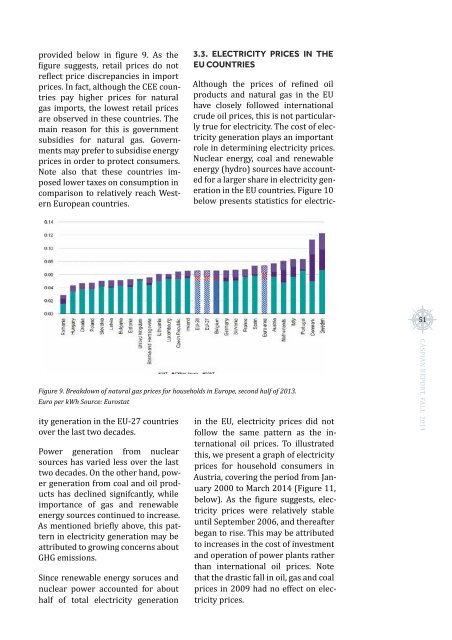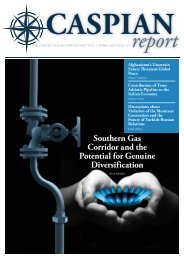Create successful ePaper yourself
Turn your PDF publications into a flip-book with our unique Google optimized e-Paper software.
provided below in figure 9. As the<br />
figure suggests, retail prices do not<br />
reflect price discrepancies in import<br />
prices. In fact, although the CEE countries<br />
pay higher prices for natural<br />
gas imports, the lowest retail prices<br />
are observed in these countries. The<br />
main reason for this is government<br />
subsidies for natural gas. Governments<br />
may prefer to subsidise energy<br />
prices in order to protect consumers.<br />
Note also that these countries imposed<br />
lower taxes on consumption in<br />
comparison to relatively reach Western<br />
European countries.<br />
3.3. ELECTRICITY PRICES IN THE<br />
EU COUNTRIES<br />
Although the prices of refined oil<br />
products and natural gas in the EU<br />
have closely followed international<br />
crude oil prices, this is not particularly<br />
true for electricity. The cost of electricity<br />
generation plays an important<br />
role in determining electricity prices.<br />
Nuclear energy, coal and renewable<br />
energy (hydro) sources have accounted<br />
for a larger share in electricity generation<br />
in the EU countries. Figure 10<br />
below presents statistics for electric-<br />
51<br />
Figure 9. Breakdown of natural gas prices for households in Europe, second half of 2013.<br />
Euro per kWh Source: Eurostat<br />
ity generation in the EU-27 countries<br />
over the last two decades.<br />
Power generation from nuclear<br />
sources has varied less over the last<br />
two decades. On the other hand, power<br />
generation from coal and oil products<br />
has declined signifcantly, while<br />
importance of gas and renewable<br />
energy sources continued to increase.<br />
As mentioned briefly above, this pattern<br />
in electricity generation may be<br />
attributed to growing concerns about<br />
GHG emissions.<br />
Since renewable energy soruces and<br />
nuclear power accounted for about<br />
half of total electricity generation<br />
in the EU, electricity prices did not<br />
follow the same pattern as the international<br />
oil prices. To illustrated<br />
this, we present a graph of electricity<br />
prices for household consumers in<br />
Austria, covering the period from January<br />
2000 to March <strong>2014</strong> (Figure 11,<br />
below). As the figure suggests, electricity<br />
prices were relatively stable<br />
until September 2006, and thereafter<br />
began to rise. This may be attributed<br />
to increases in the cost of investment<br />
and operation of power plants rather<br />
than international oil prices. Note<br />
that the drastic fall in oil, gas and coal<br />
prices in 2009 had no effect on electricity<br />
prices.<br />
CASPIAN REPORT, FALL <strong>2014</strong>










